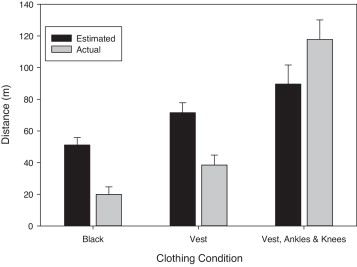Cycling at night is dangerous because bikes are often not seen by motor vehicles. This study measured the distance at which approaching drivers noticed cyclists, and compared this with when the cyclists thought they would become visible. It showed that cyclists thought they had been seen well before the motorists actually saw them. The cyclists also had false ideas about which clothing would enhance their visibility. For example, they underestimated how much reflectors on their ankles and knees improved their visibility. They also falsely believed that a fluorescent vest without any retroreflective material would improve their nighttime visibility, in this case overestimating their visibility by a factor of seven.
Twenty five cyclists took part, half were regular cyclists and half occasional. They performed the tests at night, wearing black clothing and with a light on the handlebars. The tests were then repeated with the addition of a fluorescent vest, then a fluorescent vest with retroreflective tape and finally with the fluorescent retroreflective vest plus ankle and knee reflectors. Tests were also carried out with the light static, flashing and turned off. For each test, the cyclist cycled in place on a training stand at the end of a 300 meter section of straight and relatively flat road. A car approached the cyclist from the other end of the road. Stationary headlights were positioned close the cyclist and directed towards the oncoming car, to replicate the glare of an oncoming vehicle. As the car approached the cyclists pressed a button when they believed the driver would be able to see that they were a person. The distance was then recorded. This was compared with actual visibility distances obtained from a previous study.

It was found that when cyclist’s visibility was at its worst the cyclists greatly overestimated their visibility. However, when the most effective clothing was worn (a retroreflective vest with retroreflective bands on the limbs) cyclists underestimated their visibility. This may explain why cyclists rarely wear the most effective high visibility clothing. When cyclists wore a fluorescent vest with a static light they overestimated the distance at which oncoming drivers would first recognize them by a factor of seven.
Abstract:
Bicycling at night is more dangerous than in the daytime and poor conspicuity is likely to be a contributing factor. The use of reflective markings on a pedestrian’s major joints to facilitate the perception of biological motion has been shown to greatly enhance pedestrian conspicuity at night, but few corresponding data exist for bicyclists. Twelve younger and twelve older participants drove around a closed-road circuit at night and indicated when they first recognized a bicyclist who wore black clothing either alone, or together with a reflective bicycling vest, or a vest plus ankle and knee reflectors. The bicyclist pedalled in place on a bicycle that had either a static or flashing light, or no light on the handlebars. Bicyclist clothing significantly affected conspicuity; drivers responded to bicyclists wearing the vest plus ankle and knee reflectors at significantly longer distances than when the bicyclist wore the vest alone or black clothing without a vest. Older drivers responded to bicyclists less often and at shorter distances than younger drivers. The presence of a bicycle light, whether static or flashing, did not enhance the conspicuity of the bicyclist; this may result in bicyclists who use a bicycle light being overconfident of their own conspicuity at night. The implications of our findings are that ankle and knee markings are a simple and very effective approach for enhancing bicyclist conspicuity at night.
Reference:
“Bicyclists overestimate their own night-time conspicuity and underestimate the benefits of retroreflective markers on the moveable joints”
Wood, Joanne M. (School of Optometry and Vision Science, Institute of Health and Biomedical Innovation, Queensland University of Technology, Brisbane, QLD, Australia); Tyrrell, Richard A.; Marszalek, Ralph; Lacherez, Philippe; Carberry, Trent Source: Accident Analysis and Prevention, v 55, p 48-53, 2013
<a href=””>Read the full paper…</a>
Let us know what you think